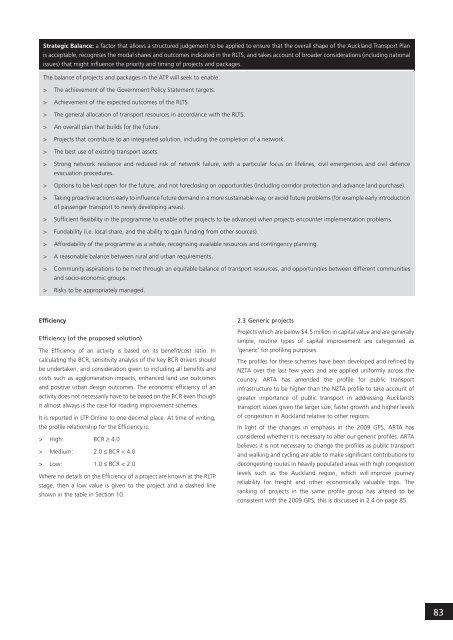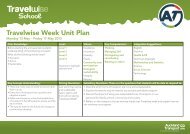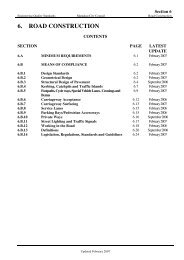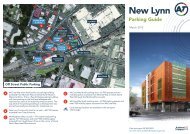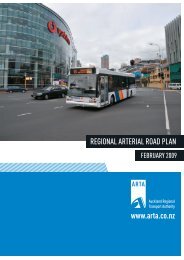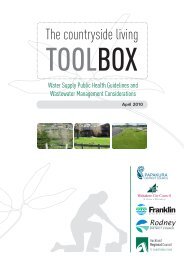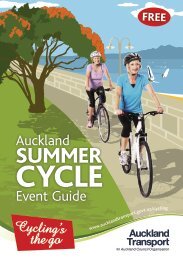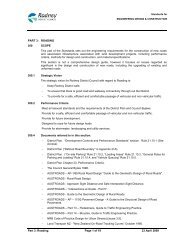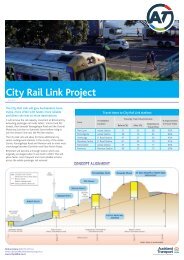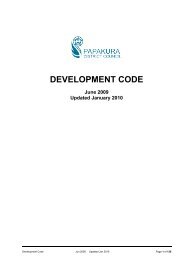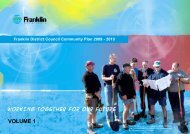Regional Land Transport Programme 2009 - 2010 (2MB) - Auckland ...
Regional Land Transport Programme 2009 - 2010 (2MB) - Auckland ...
Regional Land Transport Programme 2009 - 2010 (2MB) - Auckland ...
You also want an ePaper? Increase the reach of your titles
YUMPU automatically turns print PDFs into web optimized ePapers that Google loves.
Strategic Balance: a factor that allows a structured judgement to be applied to ensure that the overall shape of the <strong>Auckland</strong> <strong>Transport</strong> Plan<br />
is acceptable, recognises the modal shares and outcomes indicated in the RLTS, and takes account of broader considerations (including national<br />
issues) that might influence the priority and timing of projects and packages.<br />
The balance of projects and packages in the ATP will seek to enable:<br />
><br />
><br />
><br />
><br />
><br />
><br />
><br />
><br />
><br />
><br />
><br />
><br />
><br />
><br />
><br />
The achievement of the Government Policy Statement targets.<br />
Achievement of the expected outcomes of the RLTS.<br />
The general allocation of transport resources in accordance with the RLTS.<br />
An overall plan that builds for the future.<br />
Projects that contribute to an integrated solution, including the completion of a network.<br />
The best use of existing transport assets.<br />
Strong network resilience and reduced risk of network failure, with a particular focus on lifelines, civil emergencies and civil defence<br />
evacuation procedures.<br />
Options to be kept open for the future, and not foreclosing on opportunities (including corridor protection and advance land purchase).<br />
Taking proactive actions early to influence future demand in a more sustainable way, or avoid future problems (for example early introduction<br />
of passenger transport to newly developing areas).<br />
Sufficient flexibility in the programme to enable other projects to be advanced when projects encounter implementation problems.<br />
Fundability (i.e. local share, and the ability to gain funding from other sources).<br />
Affordability of the programme as a whole, recognising available resources and contingency planning.<br />
A reasonable balance between rural and urban requirements.<br />
Community aspirations to be met through an equitable balance of transport resources, and opportunities between different communities<br />
and socio-economic groups.<br />
Risks to be appropriately managed.<br />
Efficiency<br />
Efficiency (of the proposed solution)<br />
The Efficiency of an activity is based on its benefit/cost ratio. In<br />
calculating the BCR, sensitivity analysis of the key BCR drivers should<br />
be undertaken, and consideration given to including all benefits and<br />
costs such as agglomeration impacts, enhanced land use outcomes<br />
and positive urban design outcomes. The economic efficiency of an<br />
activity does not necessarily have to be based on the BCR even though<br />
it almost always is the case for roading improvement schemes.<br />
It is reported in LTP Online to one decimal place. At time of writing,<br />
the profile relationship for the Efficiency is:<br />
> High: BCR ≥ 4.0<br />
> Medium: 2.0 ≤ BCR < 4.0<br />
> Low: 1.0 ≤ BCR < 2.0<br />
Where no details on the Efficiency of a project are known at the RLTP<br />
stage, then a low value is given to the project and a dashed line<br />
shown in the table in Section 10.<br />
2.3 Generic projects<br />
Projects which are below $4.5 million in capital value and are generally<br />
simple, routine types of capital improvement are categorised as<br />
‘generic’ for profiling purposes.<br />
The profiles for these schemes have been developed and refined by<br />
NZTA over the last few years and are applied uniformly across the<br />
country. ARTA has amended the profile for public transport<br />
infrastructure to be higher than the NZTA profile to take account of<br />
greater importance of public transport in addressing <strong>Auckland</strong>’s<br />
transport issues given the larger size, faster growth and higher levels<br />
of congestion in <strong>Auckland</strong> relative to other regions.<br />
In light of the changes in emphasis in the <strong>2009</strong> GPS, ARTA has<br />
considered whether it is necessary to alter our generic profiles. ARTA<br />
believes it is not necessary to change the profiles as public transport<br />
and walking and cycling are able to make significant contributions to<br />
decongesting routes in heavily populated areas with high congestion<br />
levels such as the <strong>Auckland</strong> region, which will improve journey<br />
reliability for freight and other economically valuable trips. The<br />
ranking of projects in the same profile group has altered to be<br />
consistent with the <strong>2009</strong> GPS, this is discussed in 2.4 on page 85.<br />
83


